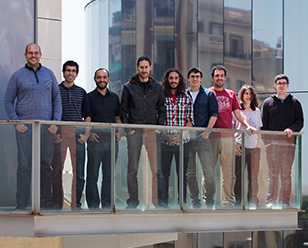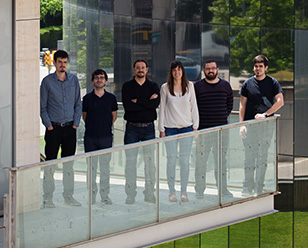Technological Report
Distributed Applications and Networks (DANA)


DIRECTOR
Joan Antoni García-Espín
TEAM
Eduard Escalona, Eduard Grasa, Albert Vico, Georg Mansky-Kummert, Miquel Tarzán, Leonardo Bergesio, Bernat Gastón, Jordi Ferrer, José Aznar, Iris Bueno, Josep Batallé, Carolina Fernández, Carlos Bermudo, Óscar Moya, Isart Canyamares, Adrián Rosselló, Josep Pons, Tanya Dobreva, Julio Barrera, Daniel Guija, Sergi Vidiella, Carles Bock.
Area description
The Distributed Applications and Networks Area at i2CAT is an R&D and Innovation area comprising an outstanding team of researchers coming from a variety of technical disciplines, either from the field of Telecommunication Engineering, Computer Science or Physics.
DANA activities are centred around three R&D lines, namely Infrastructure Control and Management (ICM), Recursive Inter-Network Architectures (RINA) and Future Internet Testbeds (FIT). Moreover, DANA has a Professional Services line to liaise with ICT sector stakeholders on a one-to-one basis, with a special focus on SMEs. Therefore, DANA develops technology based on the creation of new solutions and services to meet the challenging needs of the ICT sector in the Future Internet. In detail, DANA is focused on those technology domains that require cutting edge telecom infrastructure systems to support the management and operation of converged networks, new services and applications.
In parallel, and as a result of internal strategy, DANA has featured and promoted a wide range of activities and international partnerships, especially in European projects. This approach for international presence has allowed DANA researchers to consolidate their level of expertise and achieve an even higher level of impact in the R&D and Innovation community, both in the public and private scientific communities and in the telecommunications industry.
In the long term, the strategy of DANA is focused on developing its R&D lines and incorporating added value from innovation in order to mature and exploit internal assets and strengthen private partnership collaboration using an Open Innovation paradigm.
Research Lines
Description and goals
Infrastructure services are experiencing a drastic change in the way they are conceived and offered to clients to maximise the value and minimise the cost for the service provider in terms of control and management. Requirements such as dynamicity, flexibility, adaptability and efficiency are forging a new way of structuring the way we interact with infrastructure resources. ICM has invested a great effort in leading a number of activities for bringing research and innovation closer together. Thanks to this, i2CAT is considered an important partner that not only designs solutions, but also implements them, with this being reflected in its participation in 6 EU FP7 projects and one more starting in January 2014. ICM has made a large impact on the research community by extending and promoting OpenNaaS, which is becoming a reference framework for network management. With the developments performed within ICM projects, OpenNaaS now supports SDN network control and the implementation of NFV. Therefore, ICM is the main provider of requirements to try and make OpenNaaS a useful and important asset for i2CAT.
Keywords/Topics
R+D+i projects
Table with the projects under development during 2013
| Links | Project | Type of funding | Duration | Project Description |
|---|---|---|---|---|
| http://www.i2cat.net/en/projects/capfis | CAPFIS | MINECO | 2011 – 2013 | Compare solutions from evolutionary and revolutionary approaches in the Future Internet within the same scenario in order to be validated and compared |
| http://www.i2cat.net/en/projects/content | CONTENT | EU – FP7 | 2012 – 2015 | Define a novel convergent network architecture supporting technologies in wired and wireless network domains |
| http://www.i2cat.net/en/projects/dolfin | DOLFIN | EU – FP7 – SmartCities | 2013 – 2016 | Design and implement a control framework for the management of energy efficient data centres |
| http://www.i2cat.net/en/projects/sodales | SODALES | EU – FP7 | 2012 – 2015 | Define and develop a converged optical/wireless access network architecture that increases the spectrum utilisation efficiency and supports carrier-grade Ethernet services |
| http://www.i2cat.net/en/projects/xifi | XIFI | EU – FP7 | 2013 – 2015 | Establishment of a sustainable market for testing Future Internet infrastructures and services |
| http://www.i2cat.net/en/projects/ofertie | OFERTIE | EU – FP7 | 2012 – 2014 | Use SLA-based management of cloud hosting across multiple data-centres over OpenFlow networks for ROIA applications |
| http://www.i2cat.net/en/projects/geysers | GEYSERS | EU – FP7 | 2010 – 2013 | Generalised Architecture for Dynamic Infrastructure Services Systems. Provision and dynamic control of virtual infrastructures |
Publications
- Figuerola, S., Grasa, E., Garcia-Espin, J.A., Ferrer Riera, J., Reijs, V., Kenny, E., Lemay, M., Savoie, M., Campbell, S., Ruffini, M., O’Mahony, D., Willner, A., and St. Arnaud, B. Bringing Optical Network Control to the User Facilities: Evolution of the User Controlled Light Path Provisioning Paradigm. Cross-Layer Design in Optical Networks edited by Subra- maniam, Suresh et al.. Volume 15, 2013, pp 291-323. 10.1007/978-1-4614-5671-1-14
- Kostas Katsalis; Thanasis Korakis; Giada Landi; Giacomo Bernini; Bijan R. Rofoee; Shuping Peng; Markos Anastasopoulos; Anna Tzanakaki; Dora Christofi; Michael Georgiades; Renaud Larsen; Jordi Ferrer Riera; Eduard Escalona; Joan Antoni Garcia Espin. CONTENT project: Considerations towards a Cloud-based Internetworking Paradigm. IEEE Worskhop on Software Defined Networking for Future Network Services. IEEE, 2013.
- Bueno, I., Aznar, J. I., Escalona, E., Ferrer, J., & Garcia-Espin, J. A. (2013, November). An OpenNaaS Based SDN Framework for Dynamic QoS Control. In Future Networks and Services (SDN4FNS), 2013 IEEE SDN for (pp. 1-7). IEEE.
- Escalona, E., Aznar Baranda, J. I., Contreras Murillo, L. M., Gonzalez de Dios, O., Cossu, G., Facca, F. M., & Salvadori, E. (2013, November). Using SDN for Cloud Services Provisioning: The XIFI Use-Case. In Future Networks and Services (SDN4FNS), 2013 IEEE SDN for (pp. 1-7). IEEE.
- Markos Anastasopoulos; Anna Tzanakaki; George Zervas; Bijan R. Rofoee; Reza Nejabati; Dimitra Simeonidou; Nicola Ciulli; Giada Landi; Jordi Ferrer Riera; Joan A. Garcia Espin. Convergence of Heterogeneous Network and IT infrastructures in Support of Fixed and Mobile Cloud Services. Future Networks and Mobile Summit. FNMS 2013, 2013.
- Jordi Ferrer Riera; Josep Batalle Oronich; Eduard Escalona; Joan Antoni Garcia Espin. Management of Virtual Infrastructures through OpenNaaS. IEEE International Conference on Smart Communications in Network Technologies. pp. 1 – 5. SACONET 2013, 2013.
- G. Landi, A. Tzanakaki,, G. Bernini, D. Parniewicz, M. Anastasopoulos, B. Belter,. J. Ferrer Riera,, E. Escalona, J. A. Garcia-Espín, Virtualising converged optical network and IT infrastructures: the benefits of dynamic virtual infrastructure re-planning. In proceeding of Future Network and Mobile Summit (FNMS 2013).
- Jordi Ferrer Riera, Josep Batallé, Eduard Escalona, Albert Vico-Otón, Joan A. García-Espín. Virtualización de la Función de Enrutamiento sobre servicios de experimentación SDN en GÉANT [Virtualisation of the Routing Function on SDN experimentation services in GÉANT] .25th Technical RedIRIS Workshop. Madrid, Spain. 2013.
- S. Figuerola, C. Bock, J. Ferrer, E. Escalona, and J. Garcia-Espin, “SODALES: An Integrated Wired-Wireless Open Access Architecture,” in Asia Communications and Photonics Conference 2013, OSA Technical Digest (online) (Optical Society of America, 2013), paper AW3I.2.
- J.I. Aznar, .; Jara, M. ; Rosello, A. ; Wilson, D. ; Figuerola, S.” OpenNaaS Based Management Solution for Inter-data Centers Connectivity, “ IEEE 5th International Conference on Cloud Computing Technology and Science (CloudCom), December, 2013.
- B. Belter, J. Rodriguez Martinez, J. I. Aznar, J. Ferrer Riera, L.M. Contreras, M. Antoniak-Lewandowska, M. Biancani, J. Buysse, C. Develder, Y. Demchenko, P. Donadio, D. Simeonidou, R. Nejabati, S. Peng, L. Drzewiecki, E. Escalona, J. A. Garcia-Espin, S. Gheorghiu, M. Ghijsen, J. Gutkowski, G.Landi, G. Carrozzo, D. Parniewicz, P. Robinson, S. Soudan, “The GEYSERS Optical Test-bed: a Platform for the Integration, Validation and Demonstration of Cloud-based Infrastructure Services”, Elsevier Computer Networks, Volume 61, 14 March 2014, Pages 197–216
- C. Bock, S. Figuerola, M.C. Parker, S.D. Walker, V. Marques, V. Jungnickel, K. Habel, D. Levi “Convergent optical-wireless network for ultra-high speed fixed and radio access”, Future Network & MobileSummit, Lisbon, 03 – 05 July 2013
- C. Bock, S. Figuerola, M.C. Parker, S.D. Walker, T. Mendes, V. Marques3, V. Jungnickel, K. Habel, D. Levi, “Convergent Radio and Fibre Architectures for High-Speed Access”, Proc. International Conference on Transparent Optical Networks (ICTON), 2013, Cartagena, Spain, 23-27 June 2013.
- J. Alcober, X. Hesselbach, A. de la Oliva, A. Garcia-Saavedra, D. Roldan, C. Bock, “Internet Future Architectures for Network and Media Independent Services and Protocols” Proc. International Conference on Transparent Optical Networks (ICTON), 2013, Cartagena, Spain, 23-27 June 2013.
Knowledge progress
The main knowledge progress of ICM has focused on the consolidation and development of Software Defined Networking (SDN) knowledge and techniques. ICM has proposed the concept of SDN Apps and has researched and implemented an instance of Network Function Virtualisation (NFV) as a proof of concept. Furthermore, the integration of cloud and network technologies is becoming a fundamental part of ICM’s knowhow, which will be further developed in 2014.
Prototypes/Proofs of Concept/Services
| Name | Description | Use Case/s | Expected Time to Market |
|---|---|---|---|
| NFV Routing | Implementation of a virtual routing function (Routing VNF) for OpenFlow-based networks | Specialised and tailored routing algorithms for virtual, embedded or SDN-based networks.Virtual user routing engine for data centres, which is attachable to cloud services. | N/A |
| OpenNaaS | Framework for building network infrastructure management and control applications, based on well-defined APIs and service-oriented architecture. | Multiple use cases. OpenNaaS | N/A |
Description and goals
Driven by the requirements of the emerging applications and networks, the Internet has become an architectural patchwork of growing complexity which strains to cope with the changes. Moore’s law prevented us from recognising that the problem does not hide in the high demands of today’s applications but lies in the flaws of the Internet’s original design. The Internet needs to move beyond TCP/IP to prosper in the long term, TCP/IP has outlived its usefulness.
The Recursive InterNetwork Architecture (RINA) is a new Internetwork architecture whose fundamental principle is that networking is only inter-process communication (IPC). RINA reconstructs the overall structure of the Internet, forming a model that comprises a single repeating layer, the DIF (Distributed IPC Facility), which is the minimal set of components required to allow distributed IPC between application processes. RINA, inherently and without the need of extra mechanisms, supports mobility, multi-homing and Quality of Service, provides a secure and configurable environment, encourages a more competitive marketplace and allows for seamless adoption.
RINA research and development activities provide a unique opportunity in distributed computing and networking. RINA is a universal technological framework – which can be applied to any computer networking environment – and is a game-changer: RINA-based products will defeat the features of all the technologies currently on the market, and allow for the operation of networks at a much lower cost. Therefore the goals of the RINA research line are to develop the RINA science, specifications and technology so that RINA can be deployed in the real world. In the long term, the work of the RINA research line has to materialise in several networking products targeting different markets. The current strategy of the research line is focused on working very closely with the pioneers of this technology and position i2CAT as one of the global leaders in the RINA R&D community, as well as take part in early RINA dissemination and standardisation activities.
Keywords/Topics
R+D+i projects
Table of projects under development during 2013
| Links | Project | Type of funding | Duration | Project Description |
|---|---|---|---|---|
| http://www.i2cat.net/en/projects/irati | IRATI | EU – FP7 | 2013 – 2014 | IRATI will advance the state of the art of RINA towards an architecture reference model and specifications that are closer to enabling deployable implementations in production scenarios. The design and implementation of a RINA prototype on top of Ethernet will permit the experimentation and evaluation of RINA in comparison to TCP/IP. |
| http://www.i2cat.net/en/projects/irina | IRINA | GEANT3+ Open call | 2013 – 2015 | IRINA shall compare RINA against current networking state of the art and relevant clean-slate architecture under research; perform a use-case study of how RINA could be better used in NREN scenarios; and showcase a laboratory trial of the study. |
Publications
- S. Vrijders, D. Staesses, D. Colle, F. Salvestrini, E. Grasa, M. Tarzan and L. Bergesio “Prototyping the Recursive Internetwork Architecture: The IRATI Project Approach“, IEEE Network, Vol. 28, no. 2, March 2014. Available online.
- S. Vrijders, E. Trouva, J. Day, E. Grasa, D. Staessens, D. Colle, M. Pickavet, L. Chitkushev; “Unreliable Inter Process Communication in Ethernet: Migrating to RINA with the shim DIF“, Proceedings of 5th International Workshop on Reliable Networks Design and Modeling, RNDM 2013., pages 215-221. Available online.
- [Contributed to] G. Cook, “An Introduction to RINA, a Possible new Foundation for Global Telecommunication”, The Cook Report on Internet Protocol, September-October 2013. Available online upon subscription.
Knowledge progress
- RINA specifications. Shim DIF over 802.1Q, to overlay RINA on top of Ethernet VLANs; link-state based PDU Forwarding Table Generator policy for medium-sized DIFs.
- Prototyping. First version of a RINA prototype for the Linux Operating System, targeting both the kernel and user spaces and allowing RINA to be used directly over Ethernet.
- Experimentation. Distributed through Europe using OFELIA, involving 10-12 systems supporting RINA and two levels of normal DIFs configured with different policies.
Prototypes/Proof of Concept/Services
| Name | Description | Use Case/s | Expected Time to Market |
|---|---|---|---|
| IRATI implementation of RINA | Prototype of RINA under development by the IRATI project, targeting the Linux Operating System, both user and kernel spaces. | Virtual networking solution for datacentre networking (over UDP and/or Ethernet VLANs)Overlay networking solution for building customised VPNs optimised to different applications (WebRTC, distributed clouds, others) | 24 – 36 months |
Description and goals
Future Internet experimentation has become a broad field of investigation and innovation in order to support R&D communities all around the world. Not only are traditional R&D communities (academia) willing to have open access to cutting-edge experimentation facilities, but also private ICT sector companies and highly ICT-literate citizens are demanding tools and infrastructures to conduct their tests.
FIT research line is building the Future Internet tools for managing clouds and networks seamlessly and designing novel infrastructures in all-virtual environments. For this purpose, FIT bases its developments in software-defined networks and open network hardware approaches, to be able to fit the ever changing experimentation ecosystem. Together with the theoretical approach and the software developments, FIT has enlarged and consolidated its experimentation facilities. The OpenFlow island built in the FP7 project has been enlarged with international links to other OpenFlow and SDN-based facilities and a large number of experiments have been supported.
Keywords/Topics
R+D+i projects
Table with the projects under development during 2013
| Links | Project | Type of funding | Duration | Project Description |
|---|---|---|---|---|
| http://www.i2cat.net/en/projects/bonfire | BONFIRE | EU – FP7 | 2010 – 2013 | Deploy an experimental European Cloud Computing Future Internet Facility to validate and experiment with different cloud technologies |
| http://www.i2cat.net/en/projects/fed4fire | FED4FIRE | EU – FP7 | 2012 – 2016 | Provide a federation of FIRE experimentation facilities, developing and implementing a federation architecture |
| http://www.i2cat.net/en/projects/felix | FELIX | EU – FP7 Europe and Japan | 2013 – 2016 | Create a common framework for Future Internet (FI) experimental research into networks and distributed applications, in the EU and Japan |
| http://www.i2cat.net/en/projects/fibre | FIBRE-EU | EU – FP7 Europe and Brazil | 2011 – 2014 | Build and operate an EU-Brazil Future Internet testbed based on OpenFlow and Wireless technologies (www.fibre-eu.eu/) |
| http://www.i2cat.net/en/projects/minerva | MINERVA | EU – FP7 Open Call GN3+ | 2013 – 2015 | Deployment of a robust network coding architecture in the GÉANT OpenFlow facility, which provides a highly available backbone network infrastructure for Future Internet applications |
| http://www.i2cat.net/en/projects/novi | NOVI | EU – FP7 | 2010 – 2013 | Testbeds Federation (especially PlanetLab – FEDERICA) |
| http://www.i2cat.net/en/projects/ofelia-fp7 | OFELIA | EU- FP7 | 2010 – 2013 | Deploy and operate a European-wide OpenFlow Future Internet Facility |
| http://www.i2cat.net/en/projects/g%C3%A9ant3 | GEANT3 | EU – FP7 – Infrastructures | 2009 – 2013 | In the GEANT3 project research and services are developed in order to offer a services and advanced applications catalogue on the new research network, which is being deployed in the context of GEANT3 |
| GN3+ | EU – FP7 – Infrastructures | 2013 – 2015 | Pan-European multi-gigabit network and associated services |
Publications
- K. Kavoussanakis, A. Hume, J. Martrat, C. Ragusa, M. Gienger, K. Campowsky, G. V Seghbroeck, C. Vazquez, C. Velayos, F. Gittler, P. Inglesant, G. Carella, V. Engen, M. Giertych, G. Landi and D. Margery. “The Clouds and Services Testbed”; poster presented at CloudCom 2013 in Bristol
- S. Sallent, A. Abelém, I. Machado, L. Bergesio, S. Fdida, J. Rezende, D. Simeonidou, M. Salvador, L. Ciuffo, L. Tassiulas and C. Bermudo. “FIBRE – Intercontinental Testbed for Future Internet Experimentation”; Project poster presented at ICT 2013 in Vilnius
Knowledge progress
During 2013, the FIT team has progressed in laying the foundations for experimentation in the architectural, design and tooling perspectives. Moreover, with regards the way to design and develop tools for managing experimentation in virtualised (network and server) environments, FIT has progressed in the principles for convergent infrastructure management for the Future Internet, with a particular impact on cloud and Data Centre management.
Prototypes/Proof of Concept/Services
| Name | Description | Use Case/s | Expected Time to Market |
|---|---|---|---|
| Virtzebub | Specifications for a brand new virtualisation module that aims for a complete reservation management schema (according to predefined quotas by type of request, allowing request hysteresis, etc.), load balancing for the requested VMs, complete management of templates, enabling pluggable APIs (REST, GENI and SFA, Amazon EC) and hypervisors (such as KVM or XEN) and resource monitoring per module. | Cloud management | 8 to 12 months |
| Virt RM -Virt(ualisation) R(esource) M(anager) | Adaptation of the current Virtualisation Aggregate Manager (VT AM) to the GENI-based framework called AMsoil. As such, it adds new features such as VM reservation, periodical maintenance, etc. | Experimentation on network technologies | N/A |
Description and goals
The main goal of the PS Development Line of DANA is to deliver high quality software to bridge the gap between partners in the industry and in European projects and the research lines of DANA. Years of experience allows PS to deliver sustainable software architecture and design using methodologies to ensure non-functional as well as functional requirements. PS’s application of a thought-out mixture of well-known and cutting-edge technologies results in innovative, robust and reliable implementations.
Keywords/Topics
R+D+i projects
Table with the projects under development during 2013
| Links | Project | Type of funding | Duration | Project Description |
|---|---|---|---|---|
| http://www.i2cat.net/en/projects/mantychore | MANTYCHORE | EU – FP7 – Infrastructures | 2010 – 2013 | Infrastructures as a service for NRENs |
| JUNIPER | Private | 2012 – 2013 | Support to Juniper in design and implementation of the detNAT Junos Space application | |
| AAPD | EU – FP7 | 2013 – 2014 | Apply a refined prototype of the available platform in order to meet the requirements of the predictive analysis of a specific domain. | |
| BARLACULTURAL | Private | 2012 – 2013 | The main goal of this collaboration is to participate in the organisation to activate a place in Barcelona to explore, discover and encourage new relationships between culture, creativity, technology and innovation. |
Prototypes/Proof of Concept/Services
| Name | Description | Use Case/s | Expected Time to Market |
|---|---|---|---|
| DetNAT | DetNAT is a Junos Space application which stores historical Junos router NAT configurations. It then assists ISPs in resolving Deterministic NAT translation applied during a specific period of time in order to comply with the legislation of a country. | Query historical IP assignment | |
| Service Catalogue | The Service Catalogue enables Network Services Managers of an ISP to define and provide services by using a templating system. The system enables the provision of configuration-intensive services presented to the end-user through an abstracted, simplified API. | Service Provisioning | |
| GaaS | Grid as a Service platform that enables clients of cloud services to consume these services using an application specific, simplified API. The platform chooses the best provider given the client’s request and mediates between the client and the cloud provider. | Cloud Service Management |
Market Approach
During 2013, the Professional Services team has strengthened the cooperation with Juniper Networks Ireland, participating in the development of the DetNAT project, providing maintenance and the implementation of additional functionalities. The team has also collaborated with Quantech, in the implementation of the GaaS platform, a Grid as a Service platform that enables clients of cloud services to consume these services using an application specific, simplified API. The platform chooses the best provider given the client’s request and mediates between the client and the cloud provider.
RINA is not close to the market yet, but the RINA research line is already building a network of complementary partners to maximise the impact of RINA-based products in the mid/long term. The initial markets where RINA is more likely to be adopted are identified in section 4.4.3.
- Boston University – Research and standardisation of RINA specifications.
- TRIA Network Systems – Interoperability of RINA prototype implementations, joint design, implementation and experimentation activities.
- Nextworks – Joint development of the IRATI prototype, strategic partnership for future product development.
- WIT-TSSG – Cooperation on RINA research and development activities, specifically focused on Distributed Network Management Systems for RINA.
- Martin Geddes consulting – Collaboration on promoting RINA and making the distributed computing community more aware of its potential.
- Predictable Network Solutions – Collaboration on investigating the potential of delta-Q inspired policies for resource allocation within RINA DIFs
In the ICT sector, especially regarding Data Centre, DC networking and convergent cloud platforms are the target market for FIT developments. In particular, FIT team has developed a strong cooperation relationship with the following institutions:
- B-ISDN (DE) – OpenFlow experimentation and open hardware + SDN research
- EICT (DE) – OpenFlow and SDN experimentation, as well as SDN federation
- AIST (JP) – International federation of experimentation facilities on SDN and NSI
- Create-net (IT) – Showcasing experimentation tools for networking systems
- Nextworks (IT) – Showcasing experimentation tools for cloud systems
- University of Hungary (HU) – Research on application of network coding to SDN
- EXUS (GR) – Integration of cloud and network services
- Atos Spain (SP) – Integration of cloud and network services
- University of the Basque Country (SP) – Interconnection and experimentation on TaaS
- RedIRIS (SP) – Support for experimentation on TaaS and Géant
- PSNC (PL) – International experimentation over FIRE
- iMinds (BE) – International experimentation over FIRE
- RNP (BR) – International setup of converged SDN experimentation facilities with Brazil
- CPqD (BR) – International setup of converged SDN experimentation facilities with Brazil

- Cloud and Grid Providers
- Telecom Operators
- Data Centers Providers
- National Research and Education Networks

- Network Management and OSS/BSS providers
- Networked cloud solutions
- Open Source Framework based solutions

- Customer premises equipment
- Optical communications
- Routing and Switching equipment